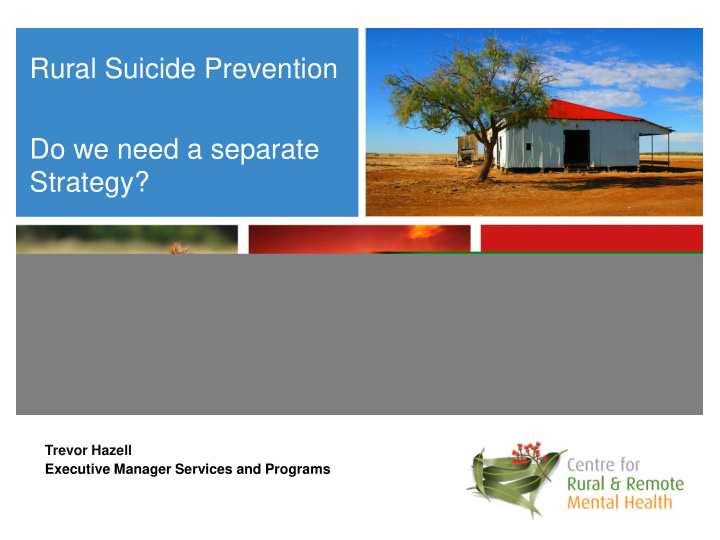



Rural Suicide Prevention Do we need a separate Strategy? Trevor Hazell Executive Manager Services and Programs
What is “Rural” Ide Ideas as • Not “major cities” (population greater than 25 250,0 0,000 00) • La Large ge rur urall ally-ba base sed citi d cities, es, ba base sed d ou outside an tside and d se sepa parate fr te from major citi om major cities, es, pe perha rhaps ps by by ge geog ograph phy y tha that le t lend nds s itself itself to mo to more ind e indus ustr try y typically classified as “rural” such as food pr prod oduc ucti tion on, , for orestr estry, , mining etc. mining etc. W Wou ould also ld also ha have oth e other i er ind ndustries ustries su such as h as t tou ouri rism, sm, fina financ nce, e, ed educ ucation tion, , an and d oth other su er supp ppor ort ser t service vices “Relative remoteness” refers to accessibility to se service vices s esp espec eciall ially y sp spec ecialt ialty y se service vices
Rur ural al health health • 32% of Australians live outside of major cities • People living in rural areas have shorter lives, higher levels of illness, and more risk factors than those living in cities • Health risk factors include: • Lower education levels • Lower incomes • Exposed to greater risk of physical injury • More likely to smoke, drink too much, do less exercise • More overweight
Rur ural al mental health mental health “The reported prevalence of mental illness in rural and remote Australia appears similar to that of major cities. Access to mental health services is substantially more limited than in major cities, and country people are less likely to seek help. Tragically, rates of self-harm and suicide increase with remoteness.” “People in rural areas regularly score better than their major city counterparts on indicators of happiness. This may be testament to the positive aspects of rural life, and the interconnectedness of people living there. In rural areas there are higher levels of civic participation, social cohesion, social capital, and volunteering and informal support networks from neighbours, friends and the community.” ARHA Factsheet
Rur ural al mental illness mental illness
Rur ural al suicide suicide
Suicide theor Suicide theory “My life is “I am alone” worthless” ( Figure adapted from Van Orden et al., 2010 ).
Systems a Systems appr pproac oach
Public Health A Public Health Appr pproac oach
Centr Centres f es for Diseas or Disease e Contr Control ol Suicide prevention has been based on a mental health treatment approach because clinical conditions (e.g., depression, anxiety, psychosis, or alcohol and substance dependence) are apparent among many who kill themselves (3). However, this approach only reaches small segments of the population who have identified risk factors and who can surmount treatment barriers, such as stigma and limited availability of or access to services (4). This orientation is also too limiting because most persons with mental health problems do not engage in suicidal behavior or die by suicide. First-time suicide attempts can be fatal, and suicide warning signs (e.g., depression, increased use of drugs or alcohol, or mood changes) can be common symptoms among non-suicidal persons and not predictive of future suicide attempts or suicide. Thus, a treatment-only approach to prevention has limited impact on national rates of suicide and nonfatal suicidal risk behavior (5). A public health approach adds a complementary, wider, and prevention-oriented focus that increases attention to the many factors across the lifespan that contribute to circumstances that promote suicidal thinking and suicide attempts. This approach offers opportunities to foster protective factors throughout a person’s life, supporting ongoing prevention well before the prospect of suicide is imminent.
Recommend
More recommend